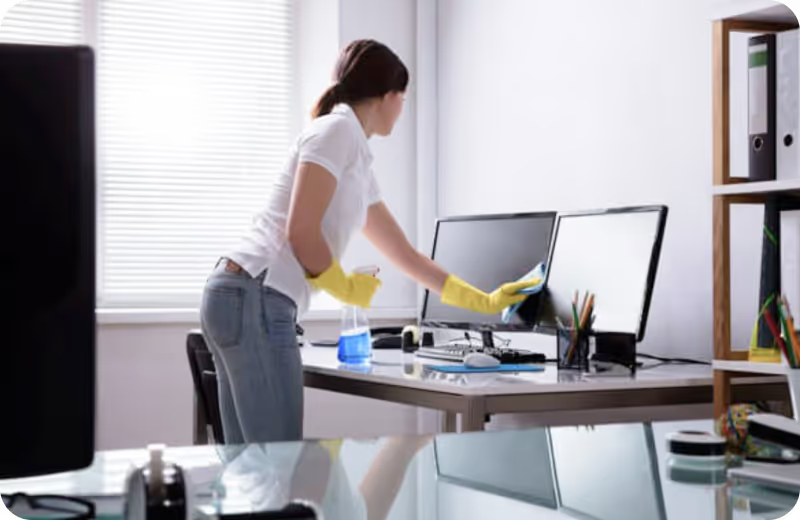
Marble has always been valued for its elegance, versatility and durability. However, because it is a natural stone, it is actually very porous and susceptible to staining. Marble, while beautiful, has a reputation for easily soaking up liquids that can leave unpleasant stains. Thankfully, the key to preserving its pristine appearance is pretty simple and straightforward.
What You’ll Need
Being proactive is always beneficial to preventing damage, especially since most mishaps caused by spills happen by accident. If you’ve got a marble floor, it’s best that you have these items nearby:
- soap
- hydrogen peroxide
- ammonia/acetone
- baking soda
- cornstarch
- liquid cleaner
- non-acidic rust remover
- marble polishing powder
- a sealant of your choice
- #0000 steel wool
- dust mop
Optional (but highly recommended):
- buffing pads
- low-speed power drill
Types of Stains
Knowing what kind of stains occur on marble and how to remove them as quickly and effectively as possible is vital to ensuring that your marble floor withstands the test of time. Here is a list of stains all homeowners should be wary of, and how to get rid of them:
1. Oil-Based Stains
If your kitchen floor is made out of marble, chances are you’re already familiar with oil-based stains. Cooking oil, grease, butter, and milk are some common household items that can easily penetrate the porous structure of the marble, leaving persistent yellow or light brown stains on your floor.
To remove stains from marble and to restore your floor’s immaculate appearance, you’ll need to draw the oil out from the marble.
Mix a soft, liquid cleanser with several drops of ammonia or acetone on the affected area, and start wiping away. If this trick doesn’t remove the stain completely, you may need the help of some poultice (you can either purchase one or make it yourself at home).
If you’re going the DIY-route and want to make your own homemade poultice, mix a tablespoon of ammonia into half a cup of hydrogen peroxide, and slowly add just enough soda bicarbonate for your mixture to reach a thick, creamy consistency (similar to peanut butter or sour cream).
Apply the finished poultice on the affected areas, cover with a plastic wrap (make sure to tape the edges well), and leave it to dry for a day or two. Rinse with water, dry, and repeat the process if necessary.
2. Organic Stains
Much like oil-based stains, organic stains are also some of the most common stains you’ll encounter if you have a marble floor. Examples include the occasional tea, coffee, or wine spill, which can leave noticeable pink or brown stains if not cleaned immediately.
Luckily, removing these stains from marble is relatively easy to do. Just mix a few drops of ammonia and 12% hydrogen peroxide on the stained area to spot clean. Though if your marble floor is darker in color, you’ll need to be more cautious with the hydrogen peroxide, as this may lighten the color of the marble.
If you want to play it safe, test out your mixture on an inconspicuous area to make sure that it won’t cause any discoloration on your marble floor.
3. Soap Scum
This one isn’t new for homeowners with marble bathroom floors. Due to frequent contact with soapy water, soap scum can build up within the marble pores, leaving unappealing stains on your marble floor.
Fortunately, soap scum can easily be remedied by 2 ingredients: water and some ammonia. Just add half a cup of ammonia to a gallon of water, and wipe the surface clean. Just don’t go overboard with the ammonia though, as this may dull marble surfaces.
4. Rust Stains
Nails, screws, metal furniture, cans and flower pots are just some items that can stain your marble floor once rust starts building up. Rust stains are usually brown or copper colored, and can be extremely difficult to remove if the stain has already set-in.
If you’re lucky and notice the stain early enough, you can use a soft wire brush to reach into the crevices of the marble without damaging the surface. But if the stain has already been sitting there for a while, you can try using a poultice or a non-acidic rust remover.
If the methods above still aren’t enough to remove the stains from marble, you may want to consider asking for professional help to restore the stone back to its original glory.
5. Soot Buildups and Smoke Damage
If you happen to have soot buildup on your marble floor, this can usually be removed with soapy water or baking soda. However, if you’re dealing with smoke damage, this may require deeper cleaning. For fire stained marble surfaces and trickier stains from soot buildup, you may need help from a poultice. Let it sit for 24 hours, and rinse thoroughly with warm water.
6. Etch Marks
Acidic substances are your marble floor’s worst nightmare. Not only do they cause stains, but they also leave etch marks due to the substance wearing away the top layer of the marble. Common offenders include lemon juice, vinegar, tomato-based sauces, or cleaning products that contain harsh chemicals.
Depending on the substance, it can either cause etches, or simultaneously etch and stain your beloved marble floor. If you’re dealing with both etches and stains, you’ll need to remove the stain with a poultice first. Alternatively, you can also use cornstarch (this is very effective for grease stains) or hydrogen peroxide pads (for lighter marble floors), though poultice might be your best bet if you’re up against a more stubborn stain.
To deal with etching, wet the surface with water and sprinkle marble polishing powder on the affected area. Using a damp cloth or buffing pad (use a low-speed power drill), buff the powder onto the stone. Though if the etched area is large and hasn’t been promptly taken care of, you may need professional help to refinish or re-polish the damaged marble.
How to Keep Your Marble Floor Clean
While removing most stains can be an easy DIY job for most homeowners, it isn’t something that you’d want to be doing all the time. Before staining becomes an issue, it is always best practice to keep your marble floor clean. If you follow the simple steps below, we can guarantee that it’ll reduce the likelihood of you having to deal with stains in the first place.
1. Preventive Measures
If you want to make your marble floor a bit more stain-resistant, we highly recommend sealing it every few months. While this won’t make the marble completely stain-proof, it will give you more legroom to fix accidental spills in the future.
Before you get started, we recommend checking in with your marble manufacturer on the right products and practices for your marble floor specifically. The last thing you want is discoloration or dullness on your marble floor.
Once you’ve acquired your trusty sealer, brush or spray it on your marble, covering the entire surface. Depending on the instructions given, wait for the recommended time period to pass or until the sealer is completely absorbed by the marble. Add an additional coat as necessary, wipe off the excess sealer, and let it sit for another 24 hours.
For more high traffic areas, it might also be a good idea to add in furniture pads or rugs to prevent scratches or potential staining from happening. Not only will it add more style to your home, but it is also a good way to lessen the dirt, dust, or other abrasive particles from moving around from one place to another.
2. Regular Cleaning
It always helps to clean your marble floor regularly to prevent buildup and scratches. You will also be able to catch spills early on, which will lessen the chances of it turning into a difficult stain.
When doing maintenance cleaning, we recommend using a dust mop to gently remove dirt or other debris. While a vacuum may get the job done quicker, you risk abrasive substances like dirt and sand being dragged around, which will cause more harm than good to your precious marble floor.
If you do catch a stain early on, warm, soapy water should be enough to remove it—just make sure to rinse well and thoroughly dry the area. And if you plan to use a cleaner, be sure that it is non-acidic, so that it won’t etch or stain your marble floor. On that note, you’ll probably also want to keep acidic substances like vinegar or lemon juice as far away from your marble floor as possible.
If the stain has already been sitting for a while, go ahead and use the above recommendations depending on the type of stain you have on your floor.
For surface level etches, you can try buffing your marble with dry #0000 steel wool. Though if the etches are deeper than that, it’s probably best to seek for a professional’s help to restore your marble.
Conclusion
The key to maintaining the beauty of your marble floor is to properly care for it. While stains can certainly be avoided, in the case that they do happen, rest assured that it’s not the end of the world for your marble floor. Just remember these handy tricks and techniques and this natural stone will reward you with many more years of luster, durability and resilience.




























